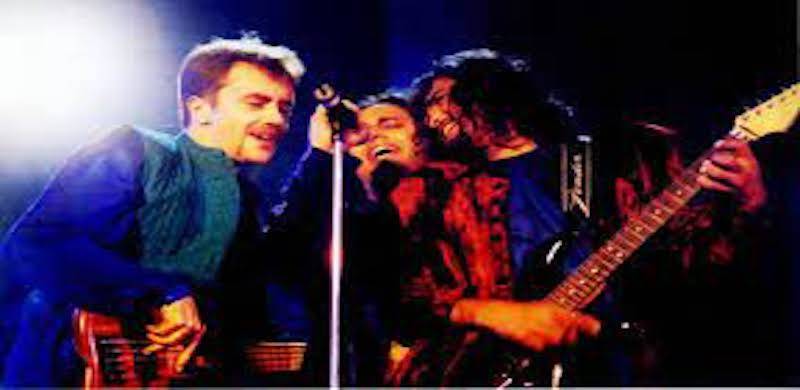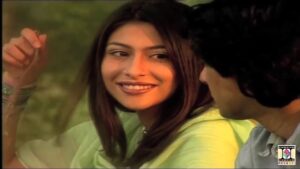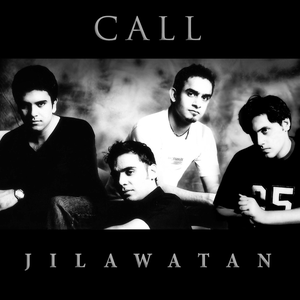
It started off with a very random find on YouTube: the Rafhan jelly ad from the days of PTV and STN. The next auto-suggestion YouTube gave was the Gillette razor commercial (hint: pehla shave chan, doosra shave…) and this was followed by the Mod Girl cream bleach ad – yet again from the PTV/STN days. While these were the ‘random-est’ possible finds, they did trigger some very desi flashbacks; and this got me digging. For simplicity sake and (more so) because I couldn’t recall too many of the adverts from back then, I restricted my search to the music scene – again, from the same era and possibly a little later. I guess this self-imposed restriction partly also had to do with the fact that an official music video has just been released for Bol by Noori – 18 years after this track otherwise and originally came out.
Nostalgia was just starting to set in – where that first step on this memory lane proved to make it quite the walk.
I recalled Indus Music and ARY Musik and wondered why we don’t see such channels more often now. But more importantly, why don't we see ‘their’ kind of music being produced anymore? There were bands like Vital Signs, Junoon, Awaz, Strings and Fuzon; and then there were solo acts like Najam Sheraz, Shehzad Roy and Sajjad Ali. These artists were absolute legends of their time and still are; but are they still making music these days? Going just one step ahead, recall that there were also those underground bands that would randomly surface with these proverbial ‘one hit wonders’ and then either (just as randomly) disappear or re-surface on an entirely different tangent. I suppose Sahil and Dil Chahay would fall into the former category, while Fakhar-e-Alam and his Bhangra Pau would fall into the latter.
If you think about it, had social media been around back then, imagine where our music industry would have been standing and at what point in time! I’m sure you understand where this sentiment is coming from.
With all these thoughts in motion, I decided to make a broadcast list (on WhatsApp) of a few close friends and occasionally share some of these gems. A couple tracks I’ve shared so far include Bin Tere Hai Kia Jeena (Jawad Ahmed), Mera Pyar (Amir Zaki), Mein Na Manoo Haar (Awaz), Tanhai (Fringe Benefits), Taali De Talli (Nazia Hasan), Suno (Nadeem Jafri), Dil Hara (Fakhir), Mein Yaad Aaoonga (Lagaan), Mujhe Pyar Chahiye (Ahmed Jahanzeb). I’m sure you get the rift: it was a combination of an understated talent and the essence of pure Pakistani pop music – making a strong artistic statement through their art.

But there was a trend we noticed with each song that was shared: with every new year that we selected music videos from, they looked a little more sophisticated and themes simultaneously and progressively appeared to be taking on new dimensions. And to entirely be honest, there are very few traces (if at all) of what our generation ‘originally’ grew up with.
Question: how and why did this happen? Can it be attributed to innovation being integral to development, including the music industry that our generation grew up with? Or is it a question of changing tastes and preferences? But when we now talk about “fusion music”, can I say that there is a huge part of our past that we’re missing and attempting to reconnect with? I am someone who occasionally enjoys melodies from the 50s, obsesses over releases from the PTV/STN/Indus Music/ARY Music era and is now partially addicted to the Nescafe Basements and Coke Studios of today. The last two are platforms where we see (in one way or another) all our favorite singers and songs every year; but is that truly enough? And these are questions I recently found asking myself.
https://www.youtube.com/watch?v=gtbgD3ucNuU
Having done some backtracking, I realised this ‘downfall’ started around the late 2000s.
I am sure everyone remembers it was the 80s, 90s and ultimately the early 2000s when the Pakistani pop music scene started building momentum before suddenly exploding into full throttle around 2003. Pepsi Battle of the Bands also premiered around the same time, in 2002. Bands like EP and Aaroh had the biggest fan following and so many of us would be bopping to songs from Noori’s debut album, Suno Keh Mein Hoon Jawaan. Fuzon had just released their cult classic ‘Ankhon keh Saagar’ and Zulfi would be rotating between EP and Call but we were cool – because both bands were so damn good.
But somewhere down the line, this music wave just randomly disappeared – with a deafening silence.
Another question: how, when and why did the music die?
Here is an open secret: I still love Ali Zafar’s ‘Channo’, and would often dream of Noori and/or Junoon reuniting. Websites like apniisp.com and songs.pk were once possibly one of the few places to download local music from. But, as we speak, I don’t know if these websites even exist and if they do, how functional they are.
So maybe it is completely understandable when we say gone are the icons, the concerts, the videos and the adrenaline.
Maybe there is a “system” in place that lets this happen. Take the example of Haroon Shahid and Junaid Khan, who were the vocalists of SYMT and Call respectively and have now become performers (in the field of acting). Both SYMT and Call can be taken as classic cases in point, representing what happened with the remaining industry.
SYMT was originally started in 2009 – at a time when the Pakistani music industry was not at its best due to security concerns, piracy and musicians relying on quantity rather than quality. But despite all that, they proved themselves as a talented bunch who have several claims to fame, including their debut single Zamana in March 2010, performances (in June 2010) at the City FM 89 World Music Day event in Lahore, 10th Lux Style Awards Nomination and appearances on Coke Studio. So, what caused their end? Referring to a 2006 interview with Express Tribune, Haroon Shahid mentioned that commercial musical events and career trajectories of most artists were changing how people consumed music. According to him, our artists make music but get known for how they looked – “People want to watch and not listen to music.”
Call went through several breakups before finally releasing their award winning single, ‘Nishaan’ in 2003; they then released Jilawatan, in 2005 and soon became huge icons. They had five to six shows every month and as non-mainstream musicians, weekends would be fully booked.

The band produced songs for Bollywood movies, came up with the Peshawer Zalmi official anthem in 2018 and then collaborated on a drum circle (again) in 2018. Brilliant stuff; but what happened? Did it have anything to do with record label monopolies and over the top demand that they brought along? This made it difficult to pay for content, when Joe Public had access to otherwise free, pirated media – at a time when there was no restriction on airing of Indian content. Given current cross border stress, this viewership on local media channels has effectively stopped.
Truth be told, there has been much discourse on what happened to our music industry over time and the causes behind it. But I do believe we must collectively ask ourselves the quintessential question: what now? Do we have it in us to bring back the music, or has it truly died? Will musicians continue playing and remixing songs from our yesteryears, or can we hope that (in time) something new will come up?
Till these questions aren’t addressed, a lot of us will probably continue grieving the death of the otherwise grand entity that Pakistani music could have been. And others, like me, will continue sharing tracks over WhatsApp – in an attempt to (somehow) keep it alive.
Nostalgia was just starting to set in – where that first step on this memory lane proved to make it quite the walk.
I recalled Indus Music and ARY Musik and wondered why we don’t see such channels more often now. But more importantly, why don't we see ‘their’ kind of music being produced anymore? There were bands like Vital Signs, Junoon, Awaz, Strings and Fuzon; and then there were solo acts like Najam Sheraz, Shehzad Roy and Sajjad Ali. These artists were absolute legends of their time and still are; but are they still making music these days? Going just one step ahead, recall that there were also those underground bands that would randomly surface with these proverbial ‘one hit wonders’ and then either (just as randomly) disappear or re-surface on an entirely different tangent. I suppose Sahil and Dil Chahay would fall into the former category, while Fakhar-e-Alam and his Bhangra Pau would fall into the latter.
If you think about it, had social media been around back then, imagine where our music industry would have been standing and at what point in time! I’m sure you understand where this sentiment is coming from.
With all these thoughts in motion, I decided to make a broadcast list (on WhatsApp) of a few close friends and occasionally share some of these gems. A couple tracks I’ve shared so far include Bin Tere Hai Kia Jeena (Jawad Ahmed), Mera Pyar (Amir Zaki), Mein Na Manoo Haar (Awaz), Tanhai (Fringe Benefits), Taali De Talli (Nazia Hasan), Suno (Nadeem Jafri), Dil Hara (Fakhir), Mein Yaad Aaoonga (Lagaan), Mujhe Pyar Chahiye (Ahmed Jahanzeb). I’m sure you get the rift: it was a combination of an understated talent and the essence of pure Pakistani pop music – making a strong artistic statement through their art.

But there was a trend we noticed with each song that was shared: with every new year that we selected music videos from, they looked a little more sophisticated and themes simultaneously and progressively appeared to be taking on new dimensions. And to entirely be honest, there are very few traces (if at all) of what our generation ‘originally’ grew up with.
Question: how and why did this happen? Can it be attributed to innovation being integral to development, including the music industry that our generation grew up with? Or is it a question of changing tastes and preferences? But when we now talk about “fusion music”, can I say that there is a huge part of our past that we’re missing and attempting to reconnect with? I am someone who occasionally enjoys melodies from the 50s, obsesses over releases from the PTV/STN/Indus Music/ARY Music era and is now partially addicted to the Nescafe Basements and Coke Studios of today. The last two are platforms where we see (in one way or another) all our favorite singers and songs every year; but is that truly enough? And these are questions I recently found asking myself.
https://www.youtube.com/watch?v=gtbgD3ucNuU
Having done some backtracking, I realised this ‘downfall’ started around the late 2000s.
I am sure everyone remembers it was the 80s, 90s and ultimately the early 2000s when the Pakistani pop music scene started building momentum before suddenly exploding into full throttle around 2003. Pepsi Battle of the Bands also premiered around the same time, in 2002. Bands like EP and Aaroh had the biggest fan following and so many of us would be bopping to songs from Noori’s debut album, Suno Keh Mein Hoon Jawaan. Fuzon had just released their cult classic ‘Ankhon keh Saagar’ and Zulfi would be rotating between EP and Call but we were cool – because both bands were so damn good.
If you think about it, had social media been around back then, imagine where our music industry would have been standing and at what point in time!
But somewhere down the line, this music wave just randomly disappeared – with a deafening silence.
Another question: how, when and why did the music die?
Here is an open secret: I still love Ali Zafar’s ‘Channo’, and would often dream of Noori and/or Junoon reuniting. Websites like apniisp.com and songs.pk were once possibly one of the few places to download local music from. But, as we speak, I don’t know if these websites even exist and if they do, how functional they are.
So maybe it is completely understandable when we say gone are the icons, the concerts, the videos and the adrenaline.
Maybe there is a “system” in place that lets this happen. Take the example of Haroon Shahid and Junaid Khan, who were the vocalists of SYMT and Call respectively and have now become performers (in the field of acting). Both SYMT and Call can be taken as classic cases in point, representing what happened with the remaining industry.
SYMT was originally started in 2009 – at a time when the Pakistani music industry was not at its best due to security concerns, piracy and musicians relying on quantity rather than quality. But despite all that, they proved themselves as a talented bunch who have several claims to fame, including their debut single Zamana in March 2010, performances (in June 2010) at the City FM 89 World Music Day event in Lahore, 10th Lux Style Awards Nomination and appearances on Coke Studio. So, what caused their end? Referring to a 2006 interview with Express Tribune, Haroon Shahid mentioned that commercial musical events and career trajectories of most artists were changing how people consumed music. According to him, our artists make music but get known for how they looked – “People want to watch and not listen to music.”
Call went through several breakups before finally releasing their award winning single, ‘Nishaan’ in 2003; they then released Jilawatan, in 2005 and soon became huge icons. They had five to six shows every month and as non-mainstream musicians, weekends would be fully booked.

The band produced songs for Bollywood movies, came up with the Peshawer Zalmi official anthem in 2018 and then collaborated on a drum circle (again) in 2018. Brilliant stuff; but what happened? Did it have anything to do with record label monopolies and over the top demand that they brought along? This made it difficult to pay for content, when Joe Public had access to otherwise free, pirated media – at a time when there was no restriction on airing of Indian content. Given current cross border stress, this viewership on local media channels has effectively stopped.
Truth be told, there has been much discourse on what happened to our music industry over time and the causes behind it. But I do believe we must collectively ask ourselves the quintessential question: what now? Do we have it in us to bring back the music, or has it truly died? Will musicians continue playing and remixing songs from our yesteryears, or can we hope that (in time) something new will come up?
Till these questions aren’t addressed, a lot of us will probably continue grieving the death of the otherwise grand entity that Pakistani music could have been. And others, like me, will continue sharing tracks over WhatsApp – in an attempt to (somehow) keep it alive.

